![]()
![]()
![]()
![]()
![]()
![]()

![]()
Sign the Guestbook
View the Guestbook

Atari Products | A Bit of History | Memo Pad | 1st Word | Links | Home
Report From The Summer
Consumer Electronics Show
|
(Continued, page 2 of 3)
Atari's big announcement was the CD-ROM, which stands for Compact Disc Read Only Memory. If you've never heard of a CD-ROM before, prepare to read dozens of articles about it in coming months, because within two years CD-ROMs will probably be everywhere. (See the accompanying article, "Monster Memory.")
Atari hooked up a working prototype of a CD-ROM to a 520ST on the second morning of the show, and the Atari exhibit was packed for the next three days. Although the hardware looked rough, the software appeared to be nearly complete. In fact, Atari hopes to have the product ready for sale by late this year or early 1986 for about $500. The software that allows the CD-ROM to work with the 520ST is being developed by an optical type setting company, Activenture, Inc. of Pacific Grove, California. Activenture has placed an entire 23 volume, nine-million-word encyclopedia plus index on a single optical disc-and the disc is still three-quarters empty. The system is so efficient that any entry can be looked up in a matter of seconds. When the CD-ROM is introduced, Atari and Activenture hope to have other databases available, too. Some examples might be additional encyclopedias, legal and medical references, cookbooks, phone books, and the whole Library of Congress card catalog. In fact, for reference works, the CD ROM may be a significant step to ward the paperless information age. "The ink-on-paper business was fairly restrictive," says Tom Rolander, vice president for engineering of Activenture. "The only way you could look at information was in the way the original publisher had organized and presented it while laying it down on paper. When using reference material- which is why we're starting with encyclopedias and things like that-the degree of usefulness is based on how well we can find the information within that material. In other words, how good its indexing system is. What we have here, by connecting the computer with the CD-ROM, is the ultimate indexing tool. We'll know every reference there is to everything that's in the database." The paperless information age, however, is encountering some resistance by those whose business depends on putting information on paper-traditional publishers. For example, Atari and Activenture had to delay announcing the name of the encyclopedia on their CD-ROM disc because the publisher didn't want any publicity until the final contract was signed. Rolander says all the publishers will probably fall in line once the first one does, but that many publishers are wary of the new technology. "They can charge $1,000 for a shelf-full of books, but how much will people be willing to pay for the same information on one of these?" asks Rolander, spinning a disc on his finger. "To consumers, it doesn't look like they're getting as much. Will people pay $500? Or $150? Or $50? We don't know yet. This may finally determine the true value of information." |
||
| <- Previous Page | Next Page -> | |
see also: Monster Memory
Atari Products | A Bit of History | Memo Pad | 1st Word | Links | Home